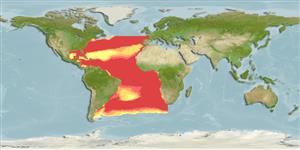Common names from other countries
>
Scombriformes (Mackerels) >
Bramidae (Pomfrets)
Etymology: Taractichthys: Greek, taraktes = confusion; for the pletora of names that have been applied to this fish + Greek, ichthys = fish (Ref. 45335); longipinnis: longipinnis meaning long-finned (Ref. 4525).
More on author: Lowe.
Environment: milieu / climate zone / depth range / distribution range
Ecologia
marinhas; oceanódromo (Ref. 51243); intervalo de profundidade 0 - 500 m (Ref. 89422), usually 42 - 200 m (Ref. 82736). Subtropical; 10°C - ? (Ref. 82736); 47°N - 68°S, 98°W - 21°E
Eastern Atlantic: Iceland and Norway southward to off Pointe Noire, Gulf of Guinea and Namibia; questionably reaching False Bay, South Africa (Ref. 4388). Absent from the Mediterranean (Ref. 4936). Western Atlantic: Nova Scotia, Canada and northern Gulf of Mexico to Puerto Rico (Ref. 7251), Bermuda, northern South America to southeastern Brazil (Ref. 82736). Highly migratory species.
Tamanho / Peso / Idade
Maturity: Lm ? range ? - ? cm
Max length : 100.0 cm SL macho/indeterminado; (Ref. 6697)
Espinhos dorsais (total) : 0; Raios dorsais moles (total) : 33 - 38; Espinhos anais: 0; Raios anais moles: 27 - 30. Grey or silvery in color, with coppery reflections (Ref. 4388).
Generally oceanic and presumably epipelagic. Often solitary but occasionally found in small schools close to shore (Ref. 82736). Feed on shrimps and squids (Ref. 82736). Young are present in all seasons (Ref. 6697). Flesh considered very good (Ref. 3576).
Life cycle and mating behavior
Maturities | Reprodução | Spawnings | Egg(s) | Fecundities | Larvas
Gomes, J., 1990. Bramidae. p. 758-764. In J.C. Quero, J.C. Hureau, C. Karrer, A. Post and L. Saldanha (eds.) Check-list of the fishes of the eastern tropical Atlantic (CLOFETA). JNCT, Lisbon; SEI, Paris; and UNESCO, Paris. Vol. 2. (Ref. 4936)
Categoria na Lista Vermelha da IUCN (Ref. 130435)
CITES (Ref. 128078)
Not Evaluated
Ameaça para o homem
Harmless
Utilização humana
Pescarias: pouco comercial
Ferramentas
Relatórios especiais
Descarregue XML
Fontes da internet
Estimates based on models
Preferred temperature (Ref.
115969): 8 - 26.3, mean 17.6 (based on 589 cells).
Phylogenetic diversity index (Ref.
82804): PD
50 = 0.7500 [Uniqueness, from 0.5 = low to 2.0 = high].
Bayesian length-weight: a=0.01820 (0.00782 - 0.04232), b=2.96 (2.76 - 3.16), in cm Total Length, based on LWR estimates for this (Sub)family-body shape (Ref.
93245).
Nível Trófico (Ref.
69278): 4.5 ±0.62 se; based on food items.
Resiliência (Ref.
120179): Muito baixo, tempo mínimo de duplicação da população maior que 14 anos (Preliminary K or Fecundity.).
Fishing Vulnerability (Ref.
59153): High to very high vulnerability (73 of 100).
